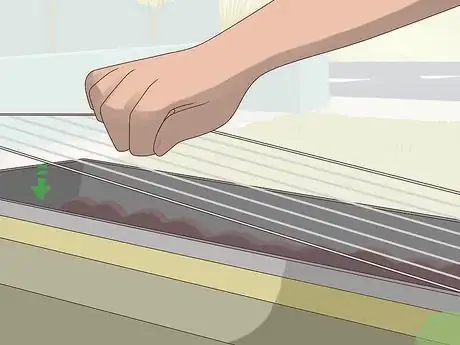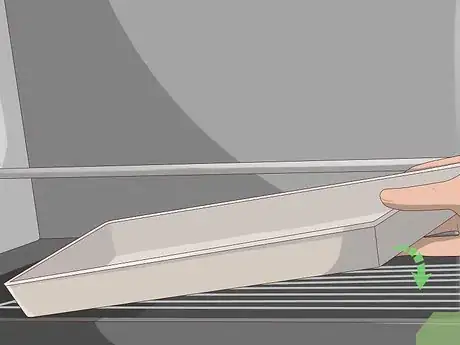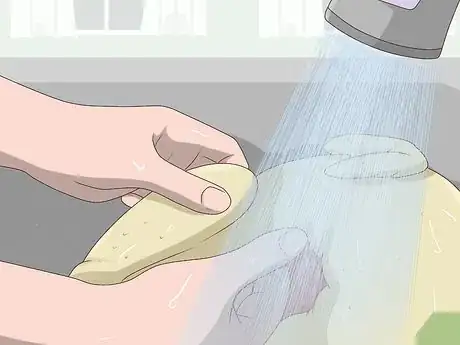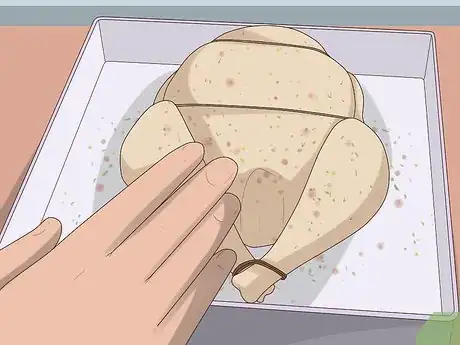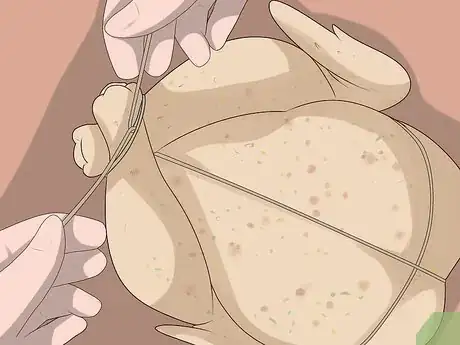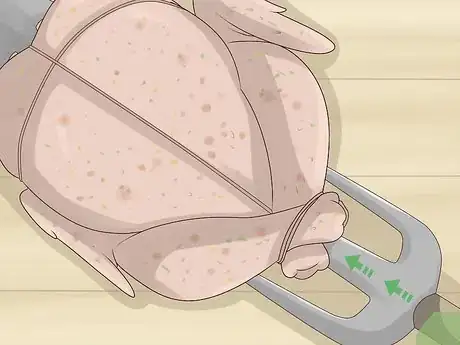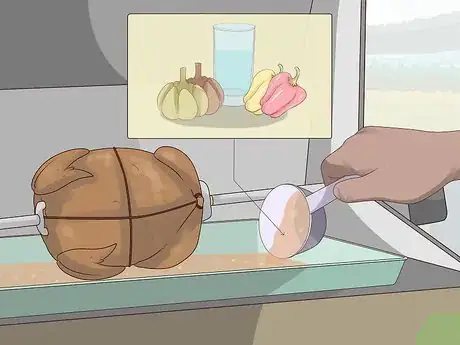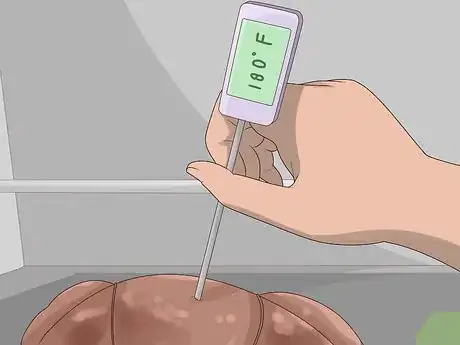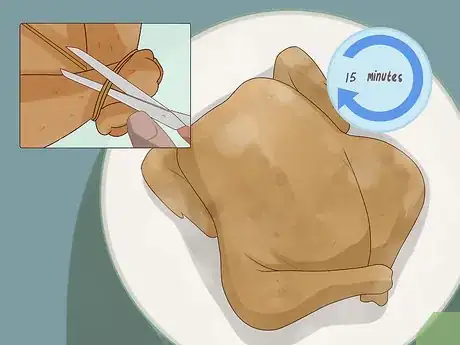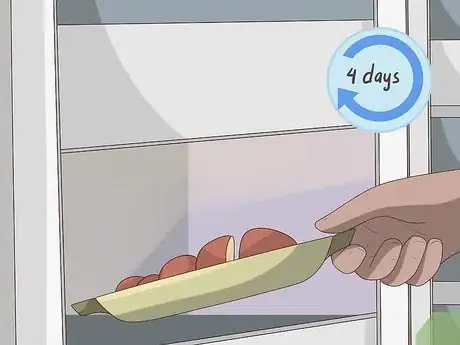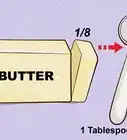This article was co-authored by wikiHow Staff. Our trained team of editors and researchers validate articles for accuracy and comprehensiveness. wikiHow's Content Management Team carefully monitors the work from our editorial staff to ensure that each article is backed by trusted research and meets our high quality standards.
There are 10 references cited in this article, which can be found at the bottom of the page.
This article has been viewed 41,412 times.
Learn more...
Rotisserie is one of the oldest styles of cooking meat. It involves slowly and constantly rotating meat over fire. The term "grilling" is a bit misleading, since rotisserie style cooking actually roasts the meat through indirect heat. By roasting slowly over a low heat, you can get meat that is juicy, tender, and delicious.
Steps
Heating up the Grill
-
1Attach the rotisserie motor to the side of the grill. If your grill doesn’t already have a rotisserie attachment on it, you will need to purchase one. The attachment should be designed for your specific type of grill. Typically, the rotisserie attachment is an electric motor that rests on a bracket outside of the grill. Follow the manufacturer’s instructions to secure it in place.[1]
- The rotisserie attachment needs to be secure in the bracket or else your meat will fall right off into the fire.
- If your grill comes with a rotisserie attachment, it will be beside the grill’s hood. If your grill doesn’t have this, you can purchase a motor online or at most retails stores that sell grills.
- Cooking rotisserie-style without a motor is possible. You will need to build a fire pit or campfire. Then, skewer the meat with rotisserie forks before setting it over the fire.
-
2Set up your gas or charcoal grill for indirect heating. Either type of grill can be used for rotisseries and the set-up is basically the same no matter what grill you have. Rotisserie cooking is done by heating meat from the sides. You need to keep your heat source on the outside edges of the grill, leaving a cooler spot in the center where the meat rests.
- For a charcoal grill, set a charcoal grate at the bottom. Spread the charcoal into piles beside the grate.
- For a gas grill, simply light up all the burners. You can adjust these later to get the proper amount of heat.
Advertisement -
3Put a drip pan in the center of the grill. The drip pan needs to be underneath where the meat will hang from the spit. If you use a charcoal grill, put the pan on the charcoal grate situated at the bottom of the grill. For a gas grill, remove the metal grates and place the pan on the metal bars that hold the grates above the heating elements.[2]
- The drip pan is important for catching juice that can burn at the bottom of the grill. You can also use it to provide extra flavorings for your meat.
- Choose a drip pan that is bigger than the meat you plan on roasting so it catches all of the juice.
-
4Preheat your grill to 350 °F (177 °C) for 15 minutes. This will be the equivalent of a medium-low temperature. Keep your grill’s lid closed to help it reach the proper temperature. When the heat is right, put your hand about 1 in (2.5 cm) over the grill. You should only be able to leave your hand there for about 5 seconds before it feels too hot.
- If your grill has a built-in rotisserie burner, turn it on along with your grill’s standard heat source.
- For a gas grill, turn off the middle burners off after the grill heats up.
Cleaning and Tying the Meat
-
1Wash the meat under running water. You don’t have to do a lot of preparation work when cooking a meat rotisserie style. For poultry, reach inside first to remove the giblet package and kidneys if they are present. Pat the meat dry with paper towels when you’re finished cleaning it.[3]
-
2Trim off excess fat near where you will skewer the meat. Look along the meat’s shorter ends, since this is where you will insert the skewers. Any pieces of fat hanging there can get in the way. Slice them off with a sharp knife.[4]
- You don’t have to remove the fat on the rest of the meat.
-
3Coat the meat with a rub or marinade if you desire. This is optional, and any meat you grill will taste great even without additional flavoring. If you want something simple, you can try mixing together a little salt, pepper, paprika, and melted butter, then baste the meat in it. Use a basting brush to apply marinades or your hands to apply rubs.[5]
- Get creative when coming up with flavor profiles! You can create all sorts of rubs and marinades by utilizing different herbs, spices, and ingredients.
- You can also stuff poultry with ingredients like butter, garlic, and lemons to provide flavor.[6]
-
4Truss the meat with kitchen twine. Before you cook the meat, it needs to be tied into a plump ball so it roasts evenly. You may need to fold the meat to make it into this shape. Any loose parts on the meat should also be tied down so they don’t fall off as they cook.[7]
- Tenderloins and boneless roasts should be rolled into a cylinder shape. Knot a new piece of twine about every 1 1⁄2 in (3.8 cm) along the roast.[8]
- For poultry, pull the wings behind the bird’s back. Wrap a piece of twine around the legs, then pull the twine all the way around to the wings. Cross over the wings, bringing the twine back around to tie it to the legs.
-
5Skewer the meat with the metal prongs. Rotisserie spits are little more than giant forks. Each skewer has 3 prongs that slide into the shorter sides of whatever meat you want to roast. Start with 1 side and slide the prongs all the way in as far as they will go. Repeat this with the second fork on the opposite side of the meat.[9]
- The forks always skewer opposite sides of the meat and the prongs always face one another. They need to be tight in the meat so the meat doesn’t fall into the fire.
- For example, if you are roasting a chicken, 1 skewer goes through the neck and the other skewer goes through the opposite end.
Using the Grill
-
1Attach the spit to the grill and start the motor. The motor will have an open hole for you to slide 1 of the forks into. Brace the second fork with your other hand as you fit the spit onto the motor. The grill itself will have rings or slots that hold the forks in place, so slide them into position. Turn on the motor to make sure the meat turns freely.[10]
- The way the spit attaches depends on your grill. A lot of grills have slots for the spit on their hoods. Other grills have slots on the grill itself.
- If you wish to use a rotisserie without a motor, you will need to spin the skewers at a slow, even pace by hand. When you get tired, have a friend take over.
-
2Add extra ingredients to the drip pan if you wish to add more flavor. Many grillmasters choose to put about 1 cup (240 mL) of water in the pan. They also add ingredients like onions, peppers, and herbs to cook as the meat roasts. Any ingredients you add won’t add much flavor to the meat itself, but you can pour them onto the meat later.[11]
- You don’t need to add anything more than hot water to the pan if you don’t want to. The water will catch the drippings and prevent them from flaring up in the pan.
- You can add wine, beer, or juice to the pan in place of water, if you wish.
-
3Close the grill’s lid and cook the meat for about 1 ½ hours. The cooking time depends on the weight of the meat and your heat setting. Expect any piece of meat to take between 15 to 20 minutes per 1 lb (0.45 kg). Heavier birds and roasts can take 2 hours or longer, so determine how much time the meat needs to reach the proper temperature.[12]
- If you cook multiple pieces of meat at the same time, use the weight to determine how much cooking time each piece needs.
- Cooking times may vary. The meat’s weight, the grill’s heat setting, and how the coals or burners are arranged affect the time estimate. You can cook rotisserie-style with an open grill, but it may take longer.
- If your grill has a rotisserie burner, you may want to turn it off after 10 or 15 minutes to prevent the meat from drying out.
-
4Test the meat 30 minutes before it's done cooking. Stick a meat thermometer into the center of the meat. If the meat isn't finished cooking, test it again every 15 minutes until it is done. This way, you don't have to see your hard work dry out. The meat should be crispy and brown but tender when it is finished.[13]
- The temperature depends on what you are cooking. For a pork roast, it should be around 160 °F (71 °C). A chicken breast should be around 180 °F (82 °C).[14]
- The meat will continue to cook after it is removed from the heat, so take it out right before it reaches the final temperature.
- If the meat isn’t done, continue cooking it. Test it again every 15 minutes to prevent if from overcooking.
-
5Let the meat rest for 15 minutes before cutting it. Move the meat to a cutting board after it is done cooking. Resist the temptation to sink your teeth in right away. When the meat has had plenty of time to rest, remove the twine and serve it.[15]
- Serve the meat with anything in the drip pan.
-
6Store the leftovers for up to 4 days in the refrigerator. Slice up any leftovers and store them resealable plastic containers. You can also wrap up the meat in foil or plastic wrap if you don’t want to cut it right away. Remember to store the meat within 2 hours of cooking it to avoid bacterial growth.[16]
- The meat can also be frozen for up to 4 months in the freezer. If it is stored longer than that, it will still be safe to eat but may not have much taste to it.
Community Q&A
-
QuestionHow do I use an electric rotisserie grill for inside the house?
 MicheleTop AnswererThose are wonderful alternatives, though some don't allow for checking internal temp while cooking. If your doesn't, you'll have to follow the directions of suggested cooking times for your appliance. Depending on the size and brand of your rotisserie, a 5 lb chicken can take anywhere from 80 to 125 minutes. You'll have to experiment, but once you've got the timing right, you can set it and forget it.
MicheleTop AnswererThose are wonderful alternatives, though some don't allow for checking internal temp while cooking. If your doesn't, you'll have to follow the directions of suggested cooking times for your appliance. Depending on the size and brand of your rotisserie, a 5 lb chicken can take anywhere from 80 to 125 minutes. You'll have to experiment, but once you've got the timing right, you can set it and forget it. -
QuestionWhat correct temperature should a chicken reached to be cooked through?
 MicheleTop AnswererWhen the internal temp of the dark meat reaches 165° F (73-74° C) or the internal temp of the white meat reaches 150°-160° F (68°-71° C), the chicken should be done. Allow to cool for 5 minutes letting residual heat bring the temp up about 5°.
MicheleTop AnswererWhen the internal temp of the dark meat reaches 165° F (73-74° C) or the internal temp of the white meat reaches 150°-160° F (68°-71° C), the chicken should be done. Allow to cool for 5 minutes letting residual heat bring the temp up about 5°. -
QuestionHow high from the coals or wood fire should it be?
 MicheleTop AnswererMost rotisseries are at a set height and can't be adjusted. If yours is adjustable, start it at the highest height and once it's close to being cooked through, lower it to crisp up the skin.
MicheleTop AnswererMost rotisseries are at a set height and can't be adjusted. If yours is adjustable, start it at the highest height and once it's close to being cooked through, lower it to crisp up the skin.
Things You'll Need
- Grill
- Coal or gas fuel
- Rotisserie motor
- Rotisserie spit
- Drip pan
- Oven gloves or mitts
- Meat thermometer
- Paper towels
- Cutting board
- Knife
- Plates
References
- ↑ https://www.chowhound.com/recipes/cuban-rotisserie-pork-loin-with-peppers-and-onions-30370
- ↑ https://www.recipetips.com/kitchen-tips/t--581/rotisserie-grilling.asp
- ↑ https://www.recipetips.com/kitchen-tips/t--1433/rotisserie-grilling-chicken.asp
- ↑ https://www.recipetips.com/kitchen-tips/t--1433/rotisserie-grilling-chicken.asp
- ↑ https://www.allrecipes.com/recipe/93168/rotisserie-chicken/
- ↑ https://www.recipetips.com/kitchen-tips/t--1433/rotisserie-grilling-chicken.asp
- ↑ https://www.youtube.com/watch?v=OW7yfODF3UA&feature=youtu.be
- ↑ https://www.youtube.com/watch?v=WZ_n-7Lumks&feature=youtu.be
- ↑ https://www.recipetips.com/kitchen-tips/t--581/rotisserie-grilling.asp
- ↑ https://www.epicurious.com/recipes/food/views/herbes-de-provence-rotisserie-chickens-238794
- ↑ http://www.myrecipes.com/recipe/rotisserie-turkey
- ↑ https://www.recipetips.com/kitchen-tips/t--581/rotisserie-grilling.asp
- ↑ https://www.allrecipes.com/recipe/93168/rotisserie-chicken/
- ↑ https://www.recipetips.com/kitchen-tips/t--581/rotisserie-grilling.asp
- ↑ https://cottagelife.com/entertaining/top-5-tips-for-rotisserie-grilling/
- ↑ https://www.stilltasty.com/fooditems/index/16799

